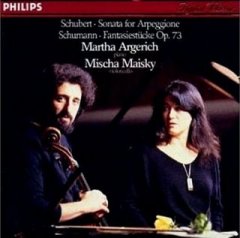Robert Schumann – Phantasie & Stücke für Piano & Cello (Argerich, Maisky) [1984]
Robert Schumann – Phantasie & Stücke für Piano & Cello (Argerich, Maisky) [1984]

Robert Schumann (1810 - 1856) Phantasiestücke (3 Fantasy Pieces) for cello & piano, Op. 73 4) 1. Zart und mit Ausdruck (3:13) 5) 2. Lebhaft, leicht (3:15) 6) 3. Rasch und mit Feuer (3:44) Stücke im Volkston for cello & piano, Op. 102 7) 1. Vanitas vanitatatum (Mit Humor) (3:17) 8) 2. Langsam (3:51) 9) 3. Nicht schnell, mit viel Ton zu spielen (4:54) 10) 4. Nicht zu rasch (2:10) 11) 5. Stark und markiert (3:06) Martha Argerich, Piano Mischa Maisky, Cello
Generally described as numbering among Schumann's least impressive works, the three Phantasiestücke, Op. 73 (1849) nonetheless contain moments of real interest. While each of the three pieces conveys a different mood, together they form a harmonically unified whole: the first begins in A minor and ends in A major, while the second and third are in A major. Further, at the end of each of the first two pieces, Schumann directs the performers to proceed to the next piece attacca, clearly demonstrating that the three pieces were conceived as a unified whole.
The first of the pieces, a song without words marked "Zart und mit Ausdruck" (Delicately and with expression), maintains a constant triplet-rhythm accompaniment in the piano, which supports a mostly independent clarinet line. The central section is distinguished by a move away from A minor and falling arpeggio figures in the clarinet. The return to the first section is nearly literal until the final harmonic shift to A major.
Piano and clarinet or cello share the melody in the blithe second piece, an intermezzo marked "Lebhaft, leicht" (Lively, light). The busy central section, itself cast in two parts, is marked by a sudden change to F major. The return of the first section soon goes astray, leading to an elegant coda.
The third piece, "Rasch und mit Feuer" (Fast and with fire) begins forte and with a sense of urgency. Triplet rhythms again dominate the piano part, while the clarinet plays its most animated melody yet. The central section provides the least harmonic contrast of all, moving unobtrusively from the opening A major to A minor. Schumann writes an extended coda to confirm both the mood and key of the piece and the entire set.
Though originally intended for the clarinet, Schumann directed that the solo part could be also performed on violin or cello. ---John Palmer, Rovi
The Fünf Stücke im Volkston (Five Pieces in the Popular Style) were written by Schumann in 1849, the same year he composed the Three Romances for oboe and piano, Op. 94, and Fantasiestücke, for clarinet and piano, Op. 73. These three collections have much in common: not only did Schumann allow for substitutions for the lead instrument in all of them, but none are difficult to perform, being designed primarily for amateur musicians of good caliber. In addition, all the various pieces are tuneful and almost completely devoid of any conflict. If there is one word to best describe the character of the Volkston pieces, it might be mellow. All are melodically appealing and exude a tranquility throughout. The middle three may be slightly more appealing, with number three being especially lovely in its rich Romanticism, both in the cello and piano writing. The second has a pastoral sweetness, while the fourth starts off in a most lively and joyous mood, then yields to a mesmerizing melody. All these pieces are worthwhile, with Schumann's deft imagination never failing to enchant. These pieces were first published in 1851. ---Robert Cummings, Rovi
download: uploaded yandex 4shared mediafire solidfiles gett mega zalivalka filecloudio anonfiles oboom
Zmieniony (Środa, 30 Kwiecień 2014 11:35)








